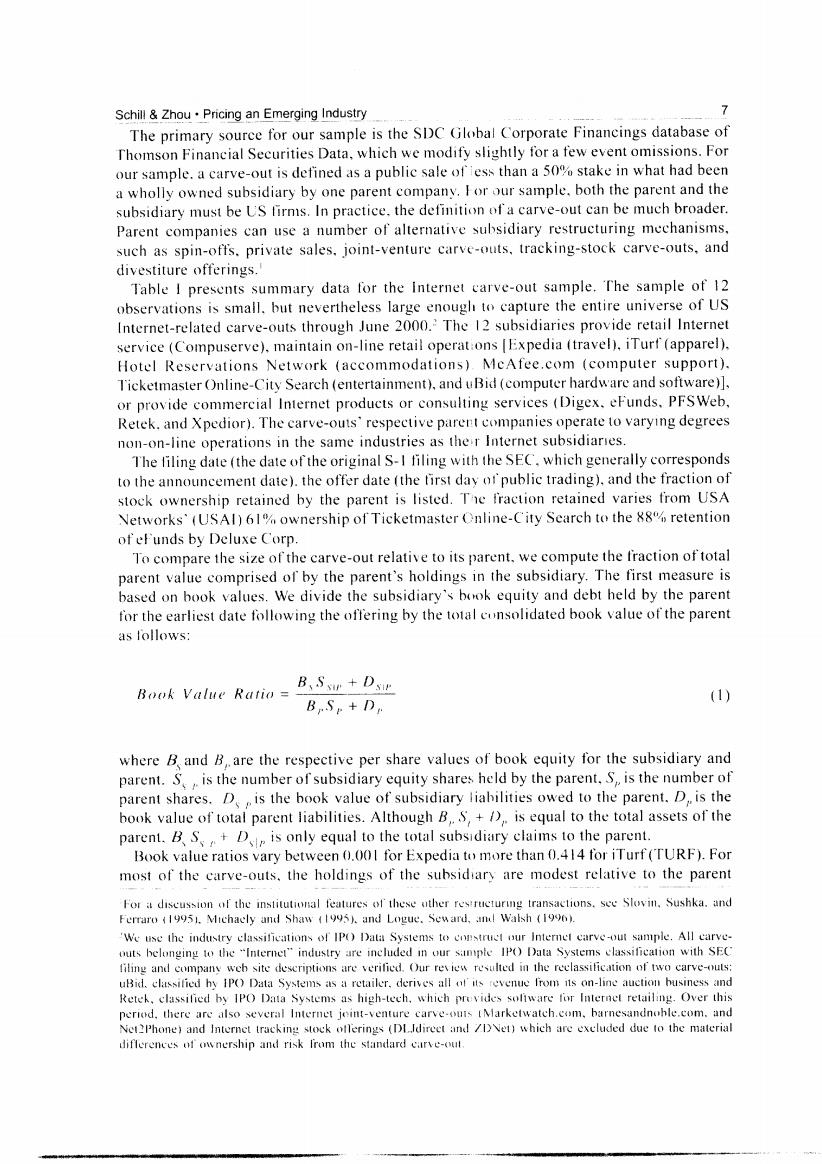正在加载图片...

Schill Zhou.Pricing an Emerging Industry 7 The primary source for our sample is the SDC Global Corporate Financings database of Thomson Financial Securities Data,which we modify slightly for a few event omissions.For our sample.a carve-out is defined as a public sale ofiess than a 50%stake in what had been a wholly owned subsidiary by one parent company.I or our sample.both the parent and the subsidiary must be US firms.In practice.the definition of a carve-out can be much broader. Parent companies can use a number of alternative subsidiary restructuring mechanisms. such as spin-offs.private sales.joint-venture carve-outs.tracking-stock carve-outs.and divestiture offerings.' Table I presents summary data for the Internet carve-out sample.The sample of 12 observations is small.but nevertheless large enough to capture the entire universe of US Internet-related carve-outs through June 2000.'The 12 subsidiaries provide retail Internet service (Compuserve).maintain on-line retail operat:ons [Expedia (travel),iTurf(apparel). Hotel Reservations Network (accommodations).MeAfee.com (computer support). T'icketmaster Online-City Search (entertainment),and uBid(computer hardware and software)]. or provide commercial Internet products or consulting services (Digex.eFunds.PFSWeb, Retek.and Xpedior).The carve-outs'respective parent companies operate to varying degrees non-on-line operations in the same industries as the r Internet subsidiaries. The filing date (the date of the original S-I filing with the SEC.which generally corresponds to the announcement date).the offer date (the first day of public trading),and the fraction of stock ownership retained by the parent is listed.The fraction retained varies from USA Networks'(USAl)61%ownership of Ticketmaster Online-City Search to the 88 retention of eFunds by Deluxe Corp. To compare the size of the carve-out relative to its parent.we compute the fraction of total parent value comprised of by the parent's holdings in the subsidiary.The first measure is based on book values.We divide the subsidiary's book equity and debt held by the parent for the earliest date following the offering by the total consolidated book value of the parent as follows: Book Value Ratio B、S+Ds (1) BS+D where B and B,are the respective per share values of book equity for the subsidiary and parent.S.is the number of subsidiary equity shares held by the parent.S,is the number of parent shares.D.is the book value of subsidiary liabilities owed to the parent.D is the book value of total parent liabilities.Although B..S,+/)is equal to the total assets of the parent.B S+D is only equal to the total subsidiary claims to the parent. Book value ratios vary between 0.001 for Expedia to more than 0.414 for iTurf(TURF).For most of the carve-outs.the holdings of the subsidary are modest relative to the parent For a discussion of the institutional features of'these uther resiructuring transactions.see Slovin.Sushka.and Ferraro (19951.Michacly and Shaw (1995).and Logue.Seward.and Walsh (1996). 'We use the industry classifications of IP()Data Systems to copstruet our Internet carveout sample.All carve- outs belonging to the "Internet"industry are ineluded in our sampie IPO Data Systems classification with SEC filing and company weh site descriptions are verified.Our review resulted in the reclassification of two carve-outs: uBid.classified hy IP()Data Systems as a retailer.derives all of'its revenue from its on-line auction business and Retek,classified by IPO Data Systems as high-tech,which provides sofiware for Internet retailing.Over this period.there are also several Internet jeint-venture carve-outs IMarketwatch.com.barnesandnohle.com.and Net?Phone)and Internet tracking stock offerings (DLIdireet and /DNet)which are exeluded due to the material diflerences of ownership and risk from the standard carve-out